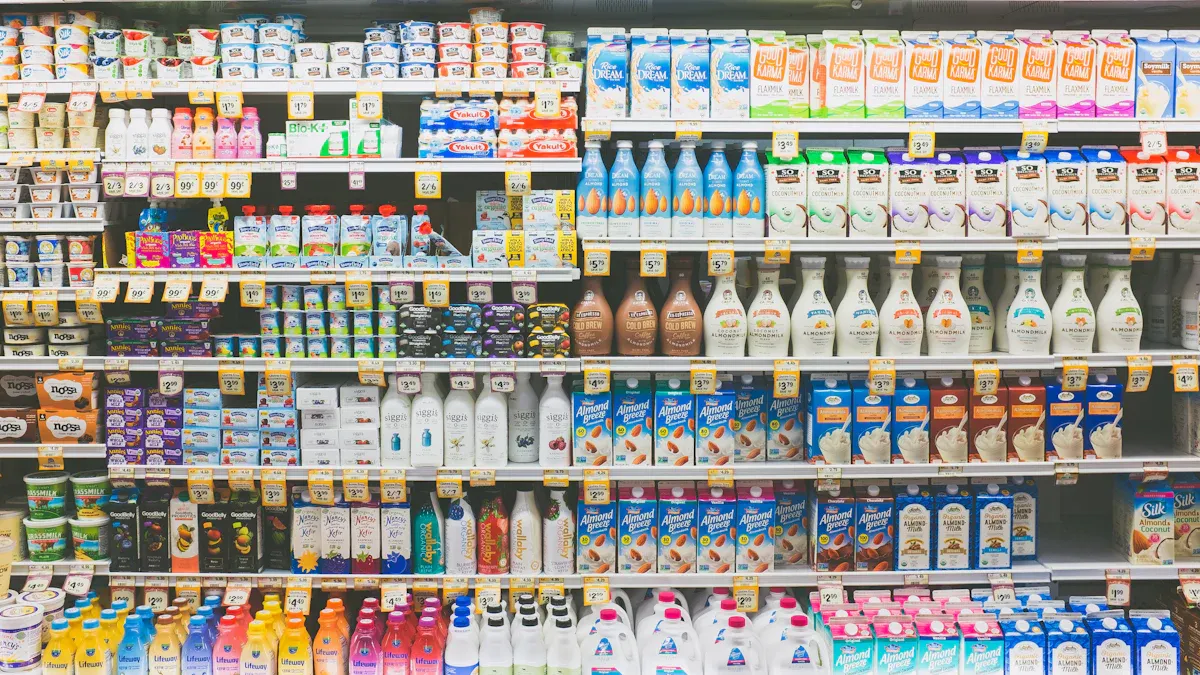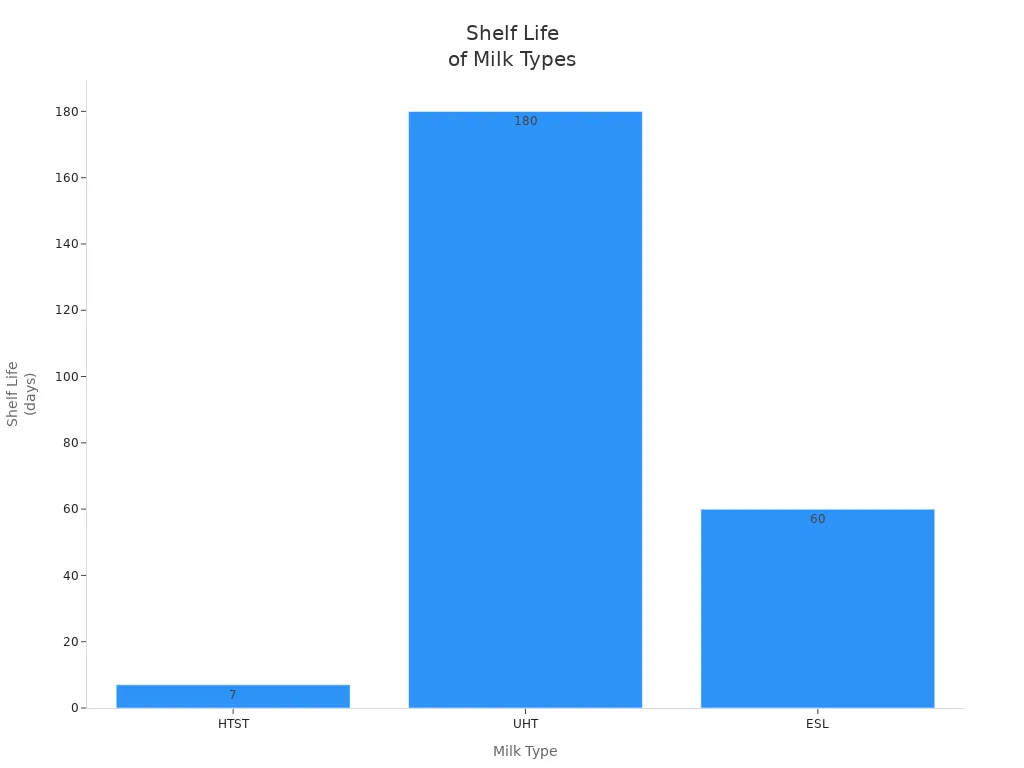Views: 0 Author: Site Editor Publish Time: 2025-09-08 Origin: Site









You want milk that tastes fresh, keeps well, and fits your budget. HTST milk gives you the best flavor but needs refrigeration and has a shorter shelf life. UHT milk lasts for months without a fridge, making it perfect for travel and storage. ESL milk offers a balance—good taste, longer shelf life, and easy access in stores. Most shoppers choose ESL or UHT for convenience, especially in busy cities. Modern Milk Production Plant technology helps make these options safe and tasty.
HTST milk offers the freshest taste but has a short shelf life of 12 to 20 days. Always keep it refrigerated to enjoy its flavor.
UHT milk lasts the longest, up to 6 to 9 months, without refrigeration until opened. It's ideal for travel and long-term storage.
ESL milk strikes a balance between taste and shelf life, lasting 21 to 45 days in the fridge. It tastes fresher than UHT milk and is a great choice for busy shoppers.
Proper storage is crucial. HTST and ESL milk must be kept cold, while UHT milk can be stored at room temperature until opened.
Consider your needs: choose HTST for fresh flavor, UHT for convenience, and ESL for a mix of both taste and longevity.

You often see HTST milk in the refrigerated section at your local store. HTST stands for High-Temperature Short-Time pasteurization. This process heats milk to about 72–74°C for 15–20 seconds. You get milk that tastes fresh and keeps most of its natural nutrients. However, you must keep this milk cold at all times. The shelf life is usually 12–20 days. Modern milk production plants, like those from SHANGHAI QINGJI BEVERAGE MACHINERY CO.,LTD, use advanced pasteurizers and tanks to make sure HTST milk stays safe and high quality.
UHT milk, also called ultra pasteurized or ultra high temperature milk, goes through a much hotter process. The milk gets heated to at least 135°C for just a few seconds. This kills all bacteria and most spores, so you can store UHT milk for months without a fridge until you open it. UHT milk is perfect if you want to stock up or travel. You will notice that UHT milk often comes in cartons that sit on shelves, not in the fridge. Milk production plants use precise heat treatment and special packaging to keep UHT milk safe and shelf-stable. SHANGHAI QINGJI BEVERAGE MACHINERY CO.,LTD designs equipment that handles this process with care, preserving taste and nutrients as much as possible.
ESL milk stands for Extended Shelf Life milk. This type of milk uses a process that sits between HTST and UHT. The milk gets heated to a temperature like 127°C for about 5 seconds. You get milk that lasts about a month in the fridge. ESL milk tastes closer to fresh milk than UHT milk does. You still need to keep ESL milk cold, but you get more time before it spoils. Advanced milk production plants, such as those from SHANGHAI QINGJI BEVERAGE MACHINERY CO.,LTD, use special equipment to make ESL milk. This equipment keeps the milk safe, extends shelf life, and protects the flavor.
Tip: Here is how advanced milk production plant equipment improves milk quality:
Provides precise heat treatment for safety.
Minimizes thermal stress to keep milk fresh.
Preserves nutrients and flavor.
Extends shelf life for all milk types.
You notice the difference in flavor as soon as you pour a glass of HTST milk. This type of milk tastes light and fresh. You get a clean, simple flavor with fewer complex notes. Many people say HTST milk reminds them of milk straight from the farm. Sensory studies show that HTST milk contains compounds like 2-butanone and dimethyl ketone, which help create its mild taste. Australian shoppers often prefer HTST milk because it tastes less cooked and more natural.
Tip: If you want the freshest flavor, choose HTST milk from the refrigerated section.
UHT milk, also called ultra pasteurized or ultra high temperature milk, tastes very different from HTST milk. You notice a cooked or caramelized flavor right away. UHT milk develops this taste because the process heats the milk to very high temperatures. The Maillard reaction creates new flavor compounds, making the milk taste slightly sweet and sometimes sulfurous. You may find notes of caramel or even a hint of egg. In China, many people accept and even enjoy these cooked and sulfur-rich flavors in UHT milk.
Milk Type | Flavor Profile | Key Compounds |
|---|---|---|
HTST | Lighter, less complex | 2-butanone, dimethyl ketone |
UHT | Cooked, caramelized, sulfur-rich | Hexanal, pentanal, nonanal, benzaldehyde |
ESL | Closer to fresh, mild | N/A |
Consumer taste tests show that UHT milk can score high for flavor, especially when people get used to its unique taste. Ten out of fourteen UHT milk samples scored above 5 on a 9-point scale, showing that many people like it.
Note: UHT milk changes flavor over time, especially if you store it at room temperature. You may notice more caramel notes and less sulfur flavor as it ages.
ESL milk gives you a middle ground between HTST and UHT milk. You get a flavor that is closer to fresh milk, but with a longer shelf life. ESL milk uses a process that heats the milk to a lower temperature than UHT milk, so it keeps more of its natural taste. Blind taste tests show that ESL milk often scores higher for freshness and palatability than UHT milk. You may notice that ESL milk tastes mild, smooth, and less cooked than UHT milk.
The average liking score for ESL milk is 4.34, which means most people find it pleasant.
ESL milk scores higher for aftertaste and milkiness compared to some fresh milk samples.
ESL milk is popular in stores because it tastes almost as fresh as HTST milk but lasts much longer.
Storage Temperature | Flavor Changes | Consumer Preference |
|---|---|---|
21°C | Faster decrease in sulfur-eggy flavor, increase in caramelized flavor | Lower liking scores for aseptic milk |
4°C | Slower changes in flavor | Higher liking scores for fresh HTST milk |
Tip: If you want milk that tastes fresh but lasts longer, ESL milk is a smart choice.
HTST milk tastes light and fresh.
UHT milk tastes cooked, caramelized, and sometimes sulfurous.
ESL milk tastes mild and smooth, closer to fresh milk than UHT milk.
You can choose the milk that matches your taste preference. If you want the freshest flavor, pick HTST milk. If you need milk that lasts for months, UHT milk is best. If you want a balance of taste and shelf life, ESL milk is the right choice.
When you buy milk, you want to know how long it will stay fresh and safe to drink. The shelf-life of each type—HTST, UHT, and ESL—depends on how the milk is processed and how you store it. Let’s look at how long you can expect each type to last and what affects their shelf-life.
HTST milk, also known as High-Temperature Short-Time milk, gives you a fresh taste but has the shortest shelf-life. You need to keep HTST milk in the refrigerator at all times. If you store it at the right temperature, usually below 4°C, you can expect a shelf-life of about 12 to 20 days. If the temperature rises, the shelf-life drops quickly. Bacteria like Bacillus cereus can grow faster at higher temperatures, making the milk spoil before the expiration date. You should always check the date on the carton and keep the milk cold to get the most out of its shelf-life.
UHT milk, which stands for Ultra High Temperature or Ultra Pasteurized milk, lasts much longer than HTST milk. You do not need to refrigerate UHT milk until you open it. The shelf-life of UHT milk ranges from 6 to 9 months when stored at room temperature. This long shelf-life comes from heating the milk to at least 135°C for a few seconds, which kills almost all bacteria and spores. Once you open the carton, you must keep the milk in the fridge and use it within a week. UHT milk is perfect if you want to stock up or need milk that will not spoil quickly.
ESL milk, or Extended Shelf-Life milk, sits between HTST and UHT milk in terms of shelf-life. You get a product that lasts longer than HTST milk but still needs refrigeration. The shelf-life of ESL milk usually ranges from 21 to 45 days, but some brands claim up to 90 days. You must keep ESL milk cold to maintain its shelf-life. If you store it at higher temperatures, the shelf-life drops, and the risk of spoilage increases. In some studies, about 15% of ESL milk packages spoiled before reaching the expiration date, so always check the milk before drinking.
Here is a quick comparison of shelf-life for each milk type:
Type of Milk | Shelf Life Range |
|---|---|
UHT | 6 to 9 months |
ESL | 21 to 45 days (up to 90 days claimed) |
HTST | 12 to 20 days (refrigerated) |
Tip: Always store HTST and ESL milk in the refrigerator to get the longest shelf-life. UHT milk can stay on the shelf until you open it.
You get the longest shelf-life from UHT milk because the ultra high temperature process kills almost all bacteria.
ESL milk uses special processing to extend shelf-life, but it still needs cold storage.
HTST milk has the shortest shelf-life and is most sensitive to temperature changes.
If you store HTST milk above 4°C, bacteria can grow faster, and the shelf-life drops.
ESL milk can last up to 120 days if you keep it cold, but spoilage can still happen.
UHT milk stays safe for months at room temperature, but once opened, you must refrigerate it.
You should always check the expiration date and store milk at the right temperature. This helps you avoid waste and enjoy fresh milk every time.

HTST milk must stay cold all the time. It leaves the plant and goes right into a fridge. This milk does not last long, so cold storage is very important. If HTST milk gets warm, bacteria can grow fast. The milk will spoil quickly. You only find HTST milk in the cold part of stores. Stores use fridges to move and show this milk. You should put HTST milk in your fridge as soon as you get home. This makes HTST milk hard to take on long trips. It is not good for places without steady fridges.
UHT milk is easier to store. You can keep UHT milk at room temperature for months. You do not need a fridge until you open it. This makes UHT milk easy to move and sell in many places. Even stores in small towns can stock UHT milk. UHT milk has special packaging that keeps it safe from germs. You can put UHT milk in your bag or keep it in your pantry. Stores like UHT milk because they do not need many fridges. This makes things simpler and cheaper for them.
ESL milk is in the middle. It lasts longer than HTST milk but still needs to be cold. ESL milk stays fresh for weeks in the fridge. This helps stores keep track of their milk better. You find ESL milk in the cold part of stores, just like HTST milk. Stores must keep ESL milk cold when moving and showing it. You should always put ESL milk in your fridge at home. ESL milk is popular in cities with good fridges. It is easy to use and tastes fresh, but you must keep it cold.
Tip: Always read the label for storage rules. Storing milk the right way keeps it safe and tasty.
Type of Milk | Processing Method | Shelf Life | Consumer Preference |
|---|---|---|---|
HTST | High Temperature Short Time pasteurization | Short | Preferred overall |
UHT | Ultra High Temperature | Long | Acceptable with training |
ESL | Extended Shelf Life | Moderate | Acceptable with training |
UHT milk needs clean packaging to stop germs.
ESL milk and HTST milk need careful handling to stay safe.
You help keep milk fresh by following cold chain rules.
HTST milk costs more because it tastes fresh. It needs special care and cold storage. The process uses high heat for a short time. This means the milk must stay cold from the plant to your home. Keeping milk cold adds extra cost. HTST milk often comes from local farms, so it does not travel far. This keeps delivery costs low. The price is higher because the milk does not last long. Stores need to sell it quickly. Prices change based on how much people want milk and what type it is. HTST milk is a classic choice, but you pay more than for other kinds.
UHT milk lasts a long time and is easy to store. You find it in boxes on shelves, not in the fridge. The process uses very high heat to kill germs. You do not need to keep UHT milk cold until you open it. This makes it cheaper to move and store. You see lower prices in places where fridges cost a lot. UHT milk is good for people who travel or want to buy lots at once. Over time, you spend less on UHT milk. Some people still like the taste of fresh milk better.
ESL milk gives you good value and is easy to use. It stays fresh longer, so stores can keep it on hand. The process uses heat between HTST and UHT levels. This helps ESL milk taste almost like fresh milk. ESL milk needs to be cold, but it lasts much longer than HTST milk. The price is between HTST and UHT milk. ESL milk costs less to make than UHT milk. It uses less energy and simple boxes. You save money on delivery because ESL milk can travel farther. ESL milk is sold in more places and helps keep prices steady. Stores teach shoppers about ESL milk and promote it more.
Tip: ESL milk helps you save money and enjoy fresh taste for weeks. You find ESL milk in many stores, and it travels well.
Here is a table that shows what changes the cost for each milk type:
Factor | HTST | UHT | ESL |
|---|---|---|---|
Processing Method | High-Temperature Short-Time | Ultra High Temperature | Extended Shelf Life |
Shelf Stability | Refrigerated | Shelf-stable | Refrigerated but not shelf-stable |
Market Share | Traditional | N/A | 8-10% of total fluid milk sales |
Pricing Adjustments | Based on Class III and IV | N/A | ESL adjuster stabilizes pricing over time |
Consumer Acceptance Efforts | N/A | N/A | Promotion and education efforts underway |
ESL milk costs less to deliver.
You see ESL milk in more stores, even where sales are low.
ESL milk helps stores find new buyers and keep prices steady.
You see more people choosing ESL milk. Stores and producers tell families and budget shoppers about ESL milk. You get more choices and better prices as ESL milk becomes more popular.
When you visit a modern milk production plant, you see many machines working together to process milk. Each piece of equipment has a special job. The plant supports HTST, UHT, and ESL milk processing. You find pasteurizers, separators, homogenizers, and tanks in every milk production plant. These machines help you get safe and tasty milk.
Here is a table showing some key equipment and what each one does:
Equipment Type | Functionality |
|---|---|
AI DIPW UHT/HTST Processor | Handles UHT, HTST, and ESL milk with high accuracy and automation. |
In-line Homogenizers | Makes milk smooth and keeps the texture even. |
Ultra-Clean Fill Hoods | Keeps milk clean during filling and stops germs from getting in. |
AccuFill Controls | Helps fill milk packages with the right amount every time. |
You also see filling and closing machines, in-container sterilizers, and packaging lines for bottles, cartons, or pouches. The milk production plant can make many dairy products, such as yogurt, cream, and even plant-based drinks. You get flexibility in packaging, so you can choose bottles, cartons, or pouches for your milk.
The milk production plant uses a series of steps to turn raw milk into safe products. You start with pre-heating the milk to about 70–80°C. Then, the plant heats the milk quickly to the right temperature for HTST, UHT, or ESL processing. For HTST, the milk reaches about 71.7°C for 15–20 seconds. UHT milk heats up to 138°C for just a moment. ESL milk uses lower heat and sometimes special filters.
After heating, the plant cools the milk fast. Homogenization comes next, making the milk smooth. The plant then fills the milk into clean packages. Aseptic packaging keeps UHT milk safe for months. The milk production plant checks every step to keep your milk fresh and safe.
Tip: The milk production plant can switch between different milk types and packaging formats. This helps you get the milk you want, in the package you like.
When you choose milk, you want to know what makes each type different. You can use this table to compare HTST, UHT, and ESL milk quickly. The table shows you how each milk type tastes, how long it lasts, what storage it needs, and how much it usually costs.
Type of Milk | Taste | Shelf Life | Cold Chain Requirements | Cost |
|---|---|---|---|---|
HTST | Fresh, mild | 7-20 days (fridge) | Needs refrigeration always | Moderate |
UHT | Altered, cooked flavor | 6-12 months | No refrigeration until open | Higher |
ESL | Close to fresh, smooth | 30-90 days (fridge) | Needs refrigeration always | Lower than UHT |
You see that HTST milk gives you the freshest taste, but you must keep it cold and use it quickly. UHT milk lasts the longest and does not need a fridge until you open it. The flavor changes because of the high heat. ESL milk gives you a taste close to fresh milk, and it stays good for weeks in the fridge. You get a good balance with esl milk if you want both taste and longer shelf life.
Tip: If you want milk that tastes almost fresh and lasts longer, esl milk is a smart pick for your home.
You can also look at how each milk type is processed and packaged. The next table helps you see the main differences:
Type of Milk | Processing Temperature | Shelf Life | Packaging |
|---|---|---|---|
HTST | ~72°C for 15 seconds | 7-20 days (fridge) | Refrigerated |
UHT | 135-154°C for 1-2 seconds | 6-12 months | Shelf-stable |
ESL | 120-135°C for 1-4 seconds | 30-90 days (fridge) | Refrigerated |
You can see that esl milk uses a process between HTST and UHT. This helps esl milk keep a fresh taste and last longer than regular milk.

You can use this chart to see how shelf life changes for each milk type. UHT milk lasts the longest, but esl milk gives you a good middle ground. HTST milk is best if you want the freshest flavor, but you need to use it fast.
Note: Always check the label for storage instructions. Keeping esl milk and HTST milk cold helps you enjoy safe and tasty milk.
You have many choices when it comes to milk. If you want the freshest taste, pick HTST milk for your family. For long trips or if you do not have a fridge, uht milk works best. If you want a balance, esl milk gives you fresh flavor and a longer shelf life. Many nutritionists say esl milk keeps nutrients and helps reduce food waste. Busy shoppers like esl milk because it stays fresh for weeks. You find esl milk in more stores now, thanks to modern milk production plants. Urban families and professionals choose esl milk for fewer grocery trips. Budget shoppers also enjoy esl milk because it offers quality and value.
Tip: Use this table to help you decide which milk fits your needs:
Who Should Choose? | Best Milk Type |
|---|---|
Families | HTST milk |
Travelers | UHT milk |
Budget Shoppers | ESL milk |
Busy Professionals | ESL milk |
Urban Households | ESL milk |
You see HTST milk in the fridge. You store uht milk on shelves until you open it. You keep esl milk cold, but it lasts longer than regular milk. Each type uses a different heat process.
You find esl milk in many stores because it stays fresh for weeks. Stores like esl milk since it reduces waste. You get more choices and better prices with esl milk.
You can freeze esl milk, but the texture may change. You might see separation after thawing. You should shake esl milk well before drinking. Freezing does not extend shelf life much.
You notice esl milk tastes close to fresh milk. Many people say esl milk is smooth and mild. You get a flavor that is better than uht milk. You enjoy esl milk if you want freshness.
You keep esl milk in the fridge for 30 to 90 days. You should check the date on the package. You must store esl milk cold to keep it safe. You use esl milk before it spoils.